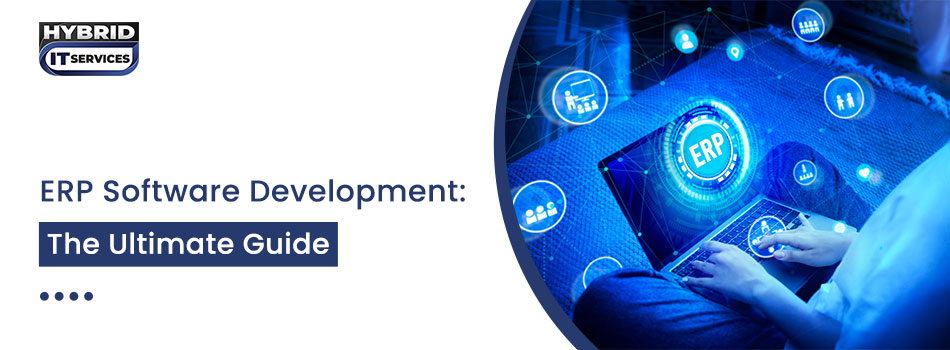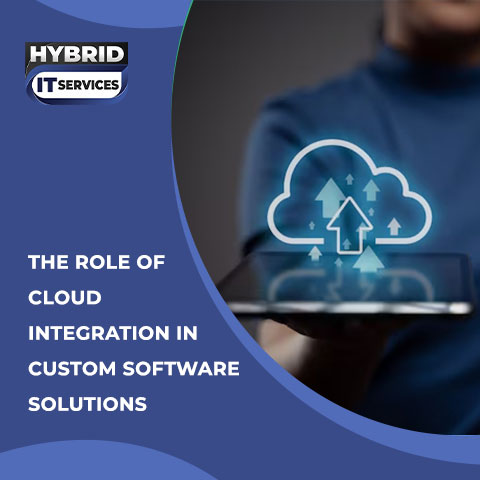Enterprise Resource Planning (ERP) software has revolutionized the way businesses manage their operations. By integrating various functions into a unified system, ERP software provides a comprehensive view of the enterprise, facilitating better decision-making and resource management.
This guide will discuss ERP software development, exploring its benefits, the choice between third-party and custom solutions, the development process, challenges, costs, and the role of Hybrid IT Services.
What is ERP Software Development?
ERP software development is the process of creating systems that integrate and manage core business processes in real time. These processes include finance, human resources, supply chain, manufacturing, services, procurement, and more. An ERP system centralizes data, enabling the seamless flow of information across departments and improving efficiency and decision-making. Developing ERP software involves understanding the specific needs of the business and building a robust technological framework to meet those needs.
Key Advantages of ERP Software Development
ERP software development offers numerous advantages that can transform business operations. By improving efficiency through automation, centralizing data, enhancing reporting capabilities, and providing scalability, ERP systems help businesses operate more effectively. Let’s explore the benefits of custom erp solutions:
1- Improved Efficiency
ERP systems are designed to streamline business processes by automating routine tasks and reducing manual data entry. This automation saves time, minimizes errors, and frees up employees to focus on more strategic tasks. For example, tasks like order processing, inventory management, and payroll can be automated, reducing the need for manual intervention. This not only speeds up these processes but also ensures they are performed consistently and accurately.
2- Centralized Data
One of the most significant advantages of ERP software is the centralization of data. All business data, from financial records to customer information, is stored in a single, unified system. This centralized repository makes it easier for employees to access and manage data, eliminating the need to work with multiple disparate systems. Centralized data enhances data accuracy and integrity, as there is a single source of truth for all business information.
3- Enhanced Reporting
ERP systems come with robust reporting and analytics tools that provide real-time insights into various aspects of the business. These tools enable users to generate detailed reports on financial performance, inventory levels, sales trends, and more.
Real-time reporting ensures that decision-makers have access to the most current data, allowing them to make informed decisions quickly. Advanced analytics features can also help identify patterns and trends, providing valuable insights that can drive strategic planning and business growth.
4- Scalability
As a business grows, its needs evolve. ERP systems are designed to be scalable, meaning they can easily adapt to accommodate increased data volumes, additional users, and new business processes. This scalability ensures that the ERP system can grow with the business, avoiding the need for frequent system overhauls or replacements.
5- Better Customer Service
ERP software development provide businesses with a comprehensive view of their customers, including order histories, preferences, and contact information. This visibility enables customer service representatives to provide more personalized and efficient service.
6- Regulatory Compliance
Many industries are subject to strict regulatory requirements regarding data management, reporting, and auditing. ERP systems often include compliance features that help businesses adhere to these regulations. These features can automate the generation of compliance reports, ensure data is stored and processed according to regulatory standards, and provide audit trails for transparency.
7- Improved Collaboration
ERP systems provide a centralized platform for communication and collaboration, breaking down barriers between departments. With all data and processes integrated into a single system, employees can easily share information and collaborate on projects. For example, sales teams can access inventory data in real-time, ensuring they provide accurate delivery estimates to customers.
Choosing Between Third-Party and Custom ERP Solutions
When choosing an ERP solution, businesses can opt for third-party (off-the-shelf) solutions or custom solutions. Each option has its advantages and disadvantages.
Third-Party Solutions
Third-party ERP solutions are pre-built systems offered by vendors. Examples include SAP, Oracle, and Microsoft Dynamics.
- Cost-Effective: Typically, less expensive upfront compared to custom solutions.
- Quick Deployment: Ready-made and faster to implement.
- Support and Updates: Vendors provide regular updates and support, ensuring the system remains current and functional.
Custom Solutions
Custom ERP solutions are developed specifically for a business, tailored to its unique needs.
- Tailored Fit: Designed to meet the specific requirements of the business.
- Scalability: Easier to scale and adapt as the business grows.
- Control: Full control over features, updates, and modifications.
ERP Software Development Process
ERP software development process involves several critical steps, each requiring careful planning and execution. Let’s see how to build an ERP system:
1- Requirement Analysis
Begin by understanding the specific needs and challenges of the business. This involves a thorough analysis of current processes and identifying areas that need improvement.
Engage with stakeholders from different departments to gather detailed requirements and ensure their needs are met. This helps in creating a comprehensive list of features and functionalities needed in the ERP system.
2- Planning
Develop a detailed project plan outlining timelines, milestones, and resource allocation. This plan serves as a roadmap for the entire development process and helps in tracking progress.
Estimate the budget, including development costs, infrastructure, and ongoing maintenance. Accurate budgeting ensures that financial resources are allocated efficiently and helps avoid unexpected costs.
3- System Design
Create the architecture of the ERP system, ensuring it can support current and future needs. This involves selecting the appropriate technology stack and designing the system’s overall structure.
Design the database schema to efficiently store and retrieve data. A well-structured database is crucial for the performance and scalability of the ERP system. Develop user-friendly interfaces that enhance the user experience. Good UI/UX design makes the system easy to use and improves user satisfaction.
4- Development
Modular Development: Build the ERP system in modules, each focusing on a specific business function. This modular approach allows for more manageable development and testing phases.
Ensure seamless integration between different modules and existing systems. Proper integration ensures that data flows smoothly across different parts of the ERP system and other business applications.
Conduct thorough testing to identify and fix bugs and ensure the system meets requirements. Testing should include unit tests, integration tests, and user acceptance testing.
5- Deployment
Migrate existing data to the new ERP system. This step involves careful planning and validation to ensure data accuracy and integrity.
Train users on how to effectively use the new system. Effective training helps users become comfortable with the ERP system and reduces resistance to change.
Deploy the ERP system and monitor its performance closely. Initial deployment should be followed by continuous monitoring to address any issues promptly.
6- Maintenance and Support
Provide continuous support to address issues and ensure the system runs smoothly. This includes technical support and help desk services for users.
Regularly update the system and add new features as needed. Continuous improvement ensures that the ERP system remains relevant and adapts to changing business needs
Development Challenges
Developing and implementing an ERP system comes with several challenges:
- High Initial Costs
- Complexity
- Change Management
- Data Migration
- Customization
- Security
How Much Does It Cost to Install an ERP System?
The cost of installing an ERP system can vary widely based on several factors. Firstly, the size of the business plays a significant role, as larger businesses typically require more complex ERP systems, leading to higher costs. Additionally, the level of customization needed influences the overall cost, with highly customized ERP solutions being more expensive than off-the-shelf options.
Cost Breakdown:
- Software Costs: Licensing or development costs.
- Hardware Costs: Servers, storage, and other infrastructure (for on-premise solutions).
- Implementation Costs: Configuration, customization, and data migration.
- Training Costs: Training employees to use the new system.
- Maintenance Costs: Ongoing support, updates, and enhancements.
Example Cost Ranges:
- Small Businesses: $10,000 - $150,000
- Medium Businesses: $150,000 - $1,000,000
- Large Enterprises: $1,000,000 - $10,000,000
How Hybrid IT Services Assist in ERP Software Development
Hybrid IT services as ERP software development company offers on-premise infrastructure with cloud services, offering a flexible and scalable environment. These services provide several advantages:
Flexibility: They allow businesses to select the best deployment model for each ERP system component, optimizing performance and cost.
Scalability: Cloud services can easily expand to accommodate growing data and user needs, ensuring the ERP system can scale with the business.
Cost Efficiency: By utilizing cloud services, companies can minimize the need for extensive on-premise infrastructure, reducing both initial costs and ongoing maintenance expenses.
Disaster Recovery: Hybrid IT services often include robust disaster recovery options, ensuring business continuity in the event of system failures or data loss.
Enhanced Security: These environments provide advanced security features by combining the strengths of on-premise and cloud security measures, ensuring data protection and compliance.
Conclusion
ERP software development is a complex but rewarding endeavor that can transform the way a business operates. By centralizing data and integrating core business processes, ERP systems enhance efficiency, improve decision-making, and support business growth. Hybrid IT services can further enhance the development and deployment of ERP systems, providing the flexibility and scalability needed in today's dynamic business environment.






